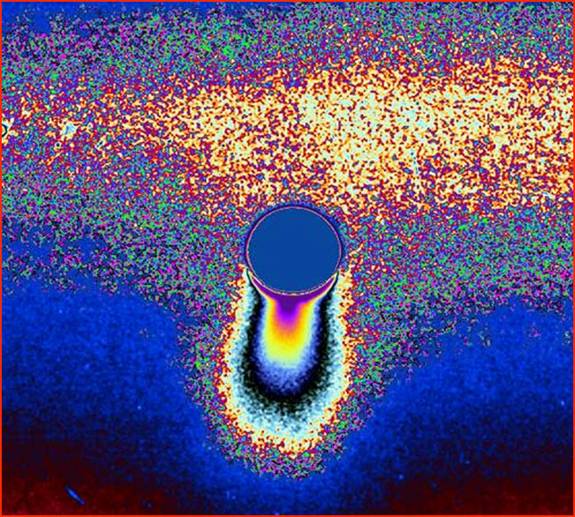
home •
about •
essential guide •
picture of the day •
thunderblogs •
news •
multimedia •
predictions •
products •
get involved •
contact
picture of the day archive subject index
Ice jets from Saturn’s small moon Enceladus explode from the surface in comet-like fashion, to feed
material into Saturn’s E ring. Credit: NASA/JPL/Space Science Institute
Mar 15, 2007
The Moving “Geysers” of Enceladus
We've stated many times on these pages that the most critical test of a theory is its predictive ability. Images from the Saturnian moon Enceladus offer such confirmation for Wallace Thornhill and his “Electric Universe” colleagues.
The "spectacular" nature of the Saturnian moon Enceladus has been the subject of more than one previous TPOD. We've discussed the "startling" discovery of a hot spot around Enceladus' south pole (an indication of electric currents coursing through Saturn’s moon and connected with the electric circuits in Saturn’s plasma sheath). We've enumerated the evidence of electrical discharge machining (EDM) processes in the past, carving intricate channel networks across vast portions of the moon’s surface. And we've discussed the explosive jets that the icy moon emits, which NASA has called "liquid water reservoirs that erupt in Yellowstone-like geysers.”
It seems that Cassini’s findings have flipped everything scientists thought they knew about Enceladus on its head. Yet the Cassini team still clings to old assumptions: the investigators simply assume that the astonishing plume activity can only be due to internal processes.
Enceladus is a small icy moon about the size of Iowa. Prior to the Cassini mission, everyone knew that such a small moon could not support active “geology” or tectonic movement. This was why the jets so caught them by surprise. The official Cassini website states, “The source of geological activity on Enceladus is a mystery. ‘We're amazed to see ice geysers on this little world that was thought to be cold and dead long ago,’ commented Dr. Dale Cruikshank of NASA Ames Research center, a member of the visual and infrared mapping spectrometer team. ‘Some unexpected process is vigorously heating the interior of Enceladus, especially the south polar region, and causing the ejection of the plumes of ice particles.’"
In other words, the shock from seeing the inconceivable was not great enough to shake the Cassini team from a purely ideological assumption.
In the March 13th TPOD “The Jets of Enceladus,” we wrote: “Electrical theorist Wallace Thornhill and his colleagues suggest there is no geyser of subsurface water analogous to the Yellowstone geyser. They say that if NASA will look they will find that the jets move across the surface. And in their motion across the surface, the electric arcs that produce the jets are creating the observed channels as they excavate material from the surface and accelerate it into space.”
It turns out that NASA has had sufficient data in hand for at least several months confirming that the jets do indeed move across the surface (see for example this video, in which the jets move in opposition to the visual rotation of the sphere). Hence, any comparison with Yellowstone’s “Old Faithful” is spurious.
All of the evidence gathered by Cassini supports the electrical interpretation. The arcs that have cut undulating and entwining filamentary channels point to the same force responsible for the energetic plumes. In electrical terms, the location of the hot spots at the south pole – a most improbable location in conventional theory – is surely no coincidence. And we can say with confidence that every attempt to find an internal source for the Enceladus plumes will prove futile.
Coming tomorrow: Enceladus Plumes "Explained"?
![]()
home •
thunderblogs •
forum •
picture of the day •
resources •
team •
updates •
contact us
EXECUTIVE EDITORS:
David Talbott, Wallace Thornhill
MANAGING EDITORS:
Steve Smith, Mel Acheson
CONTRIBUTING EDITORS: Michael Armstrong, Dwardu Cardona,
Ev Cochrane,
C.J. Ransom, Don Scott, Rens van der Sluijs, Ian Tresman
WEBMASTER: Brian Talbott
Copyright 2007: thunderbolts.info
